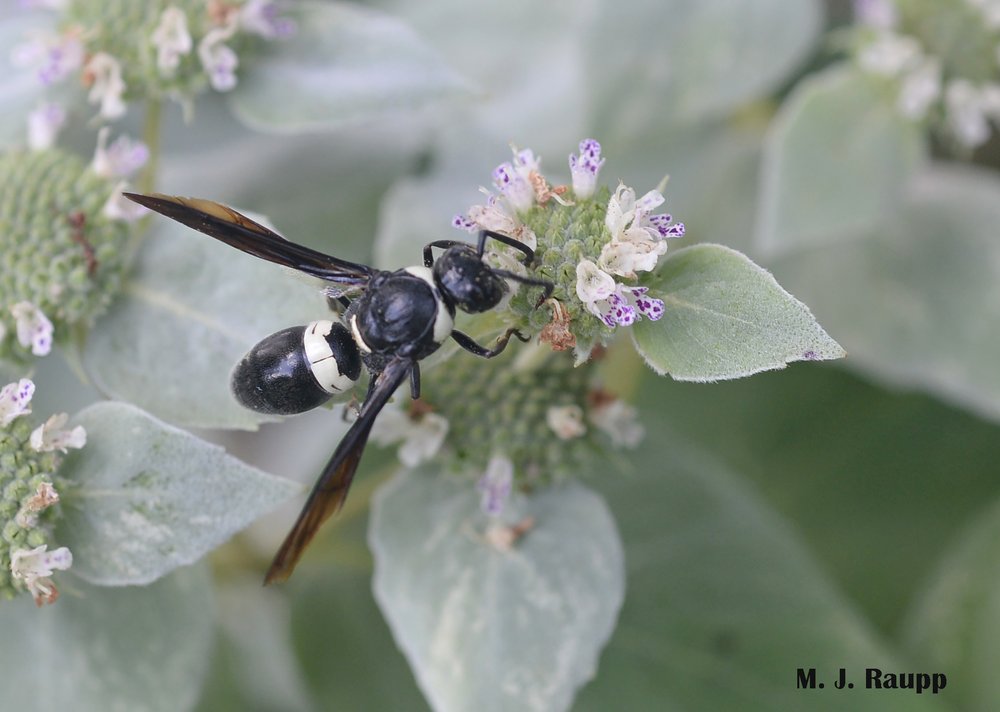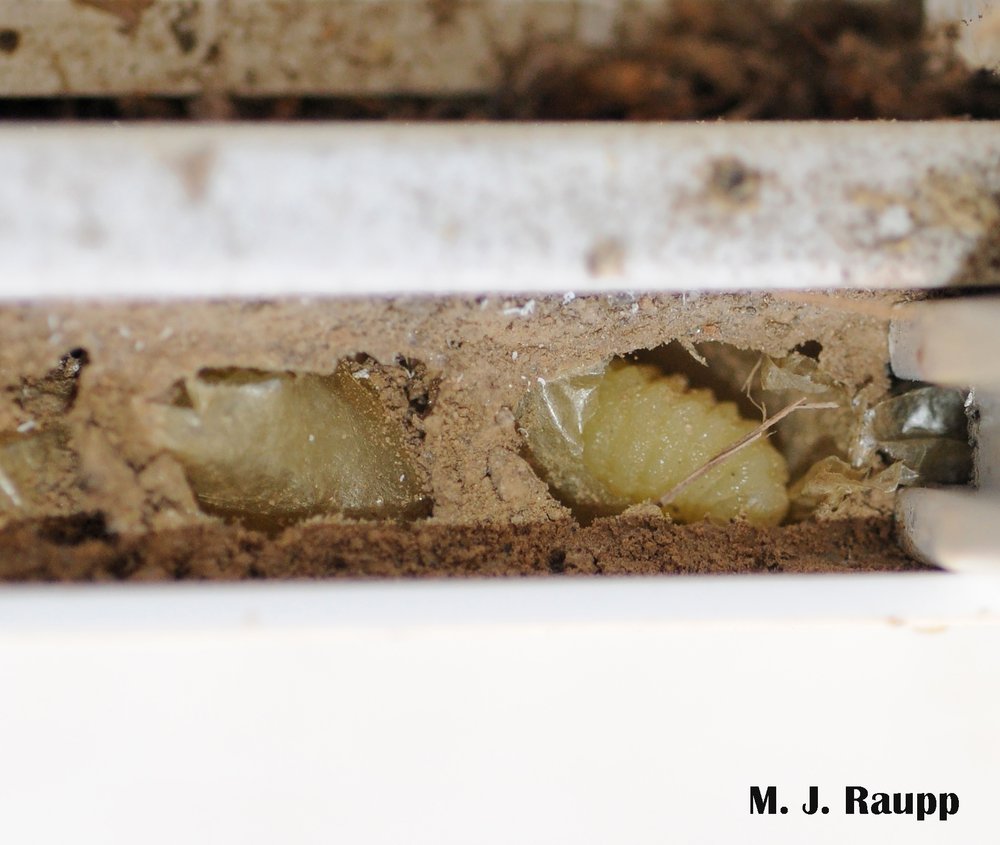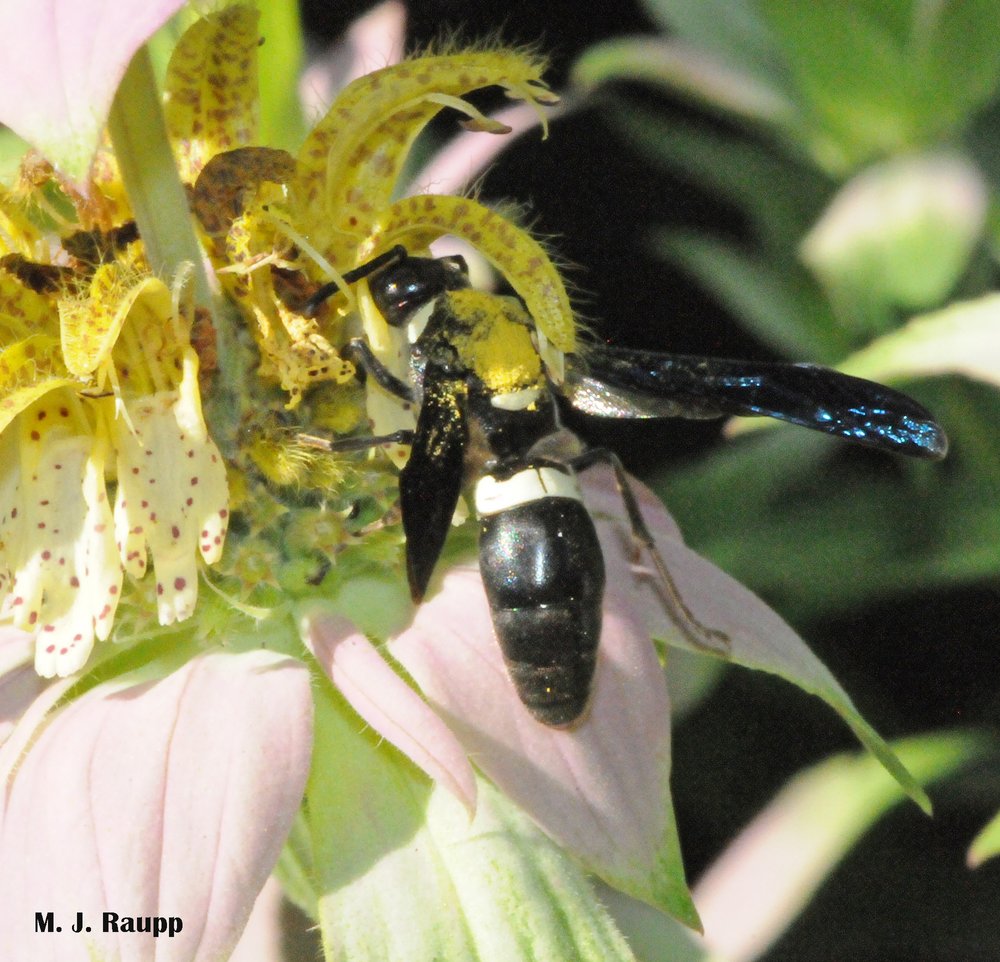
Mountain mint, Pycnanthemum, is a delightful native plant and super attractor for many pollinators, including caterpillar-hunting, four-toothed mason wasps.
Last week we met a handsome wasp inspecting galleries in wooden posts at the visitor center in Volcano National Park on the big island of Hawai’i. The keyhole wasp, Pachodynerus nasidens, belongs to a subfamily of cosmopolitan vespid wasps called the Eumeninae, commonly called potter and mason wasps. As we learned last week, keyhole wasps use galleries abandoned by other insects or human-made tubes and hollows as nurseries to raise their brood. Now let’s travel a few thousand miles east back to the DMV to visit another member of the Eumeninae.
Several years ago, an eagle-eyed Master Gardener made an inquiry regarding black and white wasps poking around her mason bee colony. My gardener friend wondered about the identity and intent of these winged wonders. Were these wasps nefarious ruffians out to eat mason bee babies and pillage their pollen cakes? You may recall meeting hard working mason bees in a previous episode of Bug of the Week and seeing photographs of hollow cardboard tubes and holes drilled in wood used to accommodate these industrious early season pollinators. Mason bees are not the only members of the bee and wasp clan that have evolved to take advantage of vacant galleries in wood. These hollow chambers excavated by wood-boring bees like carpenter bees and round-headed beetle borers are used by several species of mason wasps as nurseries to raise their brood.

Nestled in tiny chambers made of mud, wasp larvae complete their development within a channel in my vinyl window frame.
As adults, mason wasps provide two important ecosystem services, one of pollination as they seek nectar and pollen as sources of food, and another as biological control of plant-eating caterpillars. Unlike the larvae of mason bees that consume pollen cakes supplied by their mothers, mason wasps consume living but paralyzed caterpillars. Prior to the hunt for caterpillar prey, the female mason wasp deposits her egg in the chamber where caterpillars will be stored. She then hunts for prey on flowers, foliage, vegetables, and fruit. Like potter wasps we met in a previous episode of Bug of the Week, female mason wasps use a potent venom to paralyze their pray. Sometimes as many as 19 caterpillars are captured, paralyzed, and used to provision the cell where an egg awaits. Once a sufficient number of prey has been captured, the chamber is sealed with a plug of mud or sand particles. In a remarkable display of gender control, the female wasp is able to lay either a male or a female egg. Due to the shorter developmental time of the male offspring, male eggs are usually placed near the opening of the gallery. Female eggs are placed deeper within the gallery. In this way faster developing males avoid trying to climb over, around, or bore through their sisters on the way out of the nursery.
Mountain mint looks like a super food for mason wasps as they carbo-load in preparation to search for caterpillars. Watch as this female sips nectar from several blossoms before the hunt. Natural holes made in wood by other insects and human-made holes drilled in logs for mason bees make great nurseries for mason wasps. A little tickle with a wisp of wood brings a female out of her nursery. A quick look around reveals nothing amiss and back she goes into the gallery to resume her work. To my surprise, a weep-hole made in the vinyl frame of my living room window makes a great nursery for a mason wasp. After provisioning galleries with paralyzed caterpillars to feed their young, mothers gather balls of mud which will be used to seal the nursery chambers. Using jaws and patience, a female makes a beautiful mudball. With the mudball complete and cradled beneath her legs, she flies back to her nursery. It takes several loads of mud to seal the gallery completely. Here a mother puts the final touches on her handiwork. A solid coat of mud plaster helps prevent enemies from attacking and killing her developing brood.

Spotted horsemint, Monarda, is another gorgeous native perennial highly attractive to many beneficial wasps, including four-toothed mason wasps.
So, when you see these magnificent black and white wasps hovering around mason bee colonies, fear not, these are highly beneficial mason wasps looking for an empty apartment as a nursery to raise their brood. They are part of Mother Nature’s hit squad helping to reduce damage caused by caterpillars in our gardens and landscapes. You can make them part of your pest management team by providing them with critical nectar and pollen sources such as gorgeous native mountain mint and spotted horse mint.
Acknowledgements
The wonderful references “Trap nesting wasps and bees: Life histories, nests, and associates” by Karl Krombein and “The Cocooning Habit of the Wasp Monobia quadridens” by Phil Rau were consulted to prepare this episode.
No comments:
Post a Comment